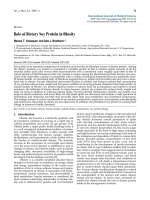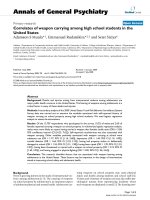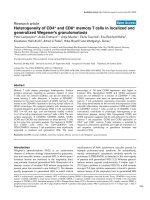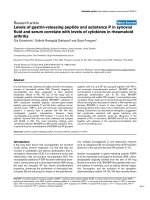Báo cáo y học: " Level of dietary protein intake affects glucose turnover in endurance-trained men" doc
Bạn đang xem bản rút gọn của tài liệu. Xem và tải ngay bản đầy đủ của tài liệu tại đây (268.06 KB, 4 trang )
SHOR T REPO R T Open Access
Level of dietary protein intake affects glucose
turnover in endurance-trained men
Stefan M Pasiakos, William F Martin, Charu S Sharma, Matthew A Pikosky, Patricia C Gaine, Douglas R Bolster,
Brian T Bennett and Nancy R Rodriguez
*
Abstract
Background: To examine the effects of higher-protein diets on endogenous glucose metabolism in healthy,
physically active adults, glucose turnover was assessed in five endurance-trained men (age 21.3 ± 0.3 y, VO
2peak
70.6 ± 0.1 mL kg
-1
min
-1
) who consumed dietary protein intakes spanning the current dietary reference intakes.
Findings: Using a rando mized, crossover design, volunteers consumed 4 week eucaloric diets providing either a
low (0.8 g kg
-1
d
-1
; LP), moderate (1.8 g kg
-1
d
-1
; MP), or high (3.6 g kg
-1
d
-1
; HP) level of dietary protein. Glucose
turnover (Ra, glucose rate of appearance; and Rd glucose rate of disappearance) was assessed under fasted, resting
conditions using primed, constant infusions of [6,6-
2
H
2
] glucose. Glucose Ra and Rd (mg kg
-1
min
-1
) were higher
for MP (2.8 ± 0.1 and 2.7 ± 0.1) compared to HP (2.4 ± 0.1 and 2.3 ± 0.2, P < 0.05) and LP (2.3 ± 0.1 and 2.2 ± 0.1,
P < 0.01) diets. Glucose levels (mmol/L) were not different (P > 0.05) between LP (4.6 ± 0.1), MP (4.8 ± 0.1), and HP
(4.7 ± 0.1) diets.
Conclusions: Level of protein consumption influenced resting glucose turnover in endurance athletes in a state of
energy balance with a higher rate of turnover noted for a protein intake of 1.8 g kg
-1
d
-1
. Findings suggest that
consumption of protein in excess of the recommended dietary allowance but within the current acceptable
macronutrient distribution range may contribute to the regul ation of blood glucose when carbohydrate intake is
reduced by serving as a gluconeogenic substrate in endurance-trained men.
Introduction
Increasing dietary protein at the expense of carbohy-
drate in either Type 2 diabetics or in overweight adults
in response to energy restriction improves insulin sensi-
tivity and glycemic control [1-5]. Studies have shown
that protein intake in excess of the current recom-
mended dietary allowance (RDA: 0.8 g kg
-1
d
-1
)stabi-
lizes blood glucose and reduces the postprandial insulin
response after weight loss [2,3]. The metabolic advan-
tage of a diet which provides dietary protein above the
RDA specific to glucose utilization in healthy, physically
active adults is unclear [6].
Higher-protein intakes are recommended for physi-
cally active adults who routinely participate in e ndur-
ance exercise [7-9]. To date, no studies have
investigated the impact of dietary protein intake on glu-
cose homeostasis in endurance-trained adults. The
objective of our study was to examine the effects of con-
suming dietary protein intakes spanning the current
Acceptable Macronutrient Distribution Range (AMDR)
on resting glucose turnover in endurance-trained men
[10]. We hypothesized that protein availability would
influence glucose turnover during a eucaloric state such
that glucose rate of appearance (Ra) would be greater
when the proportion of energy derived from dietary pro-
tein was increased with a simultaneous reduction in car-
bohydrate consumption.
Methods
Using a randomized, crossover design, five endurance-
trained men (21.3 ± 0.3 y, 179.1 ± 1.6 cm, 70.6 ± 0.1 kg,
8.7 ± 0.4% fat, VO
2peak
70.6 ± 0.1 mL kg
-1
min
-1
)were
assigned to a diet providing 0.8 (Low Protein; LP), 1.8
(Moderate Protein; MP) or 3.6 (High Protein; HP)
grams of protein per kilogram body mass per day for
four weeks. Participants crossed o ver and consumed
each of the remaining diets in randomized order
* Correspondence: u
Department of Nutritional Sciences, University of Connecticut, Storrs, CT, USA
Pasiakos et al . Journal of the International Society of Sports Nutrition 2011, 8:20
/>© 2011 Pasiakos et al; licensee BioMed Central Ltd. This is an Open Access article distributed under the terms of th e Creative Commons
Attribution License ( which permits unrestricted use, distribution, and reproduction in
any medium, provided the original work is properly cited.
following a 2 wk wash out period between each diet
intervention. Actual macronutrient composition of the
each diet was 48% carbohydra te (5.4 g kg
-1
d
-1
), 26% fat,
and 26% protein (3.1 g kg
-1
d
-1
) for HP, 60% carbohy-
drate (7.4 g kg
-1
d
-1
), 26% fat, and 14% protein (1.8 g
kg
-1
d
-1
) for MP, and 66% carbohydrate (8.3 g kg
-1
d
-1
),
27% fat, and 7% protein (0.9 g kg
-1
d
-1
) for LP. Extended
details of the diet intervention have been previously
reported [8]. Volunteers maintained their normal level
of training throughout the study. However, exercise was
restricted for 24 h before glucose turnover assessments
to minimize the potential influence of previous exercise
on study measures.
Glucose turnover was assessed after 3 wks of each 4
wk diet intervention using a 120 min primed, constant
infusion of [6,6-
2
H
2
]glucose(17μmol kg
-1
;0.2μmol
kg
-1
min
-1
; Cambridge Isotope Laboratories, Andover,
MA) at 0700 h after an overnight fast (≥ 10 h). Arter ia-
lized blood samples were obtained from a dorsal hand
vein at baseline, 60, 75, 90, 10 5 and 120 min to deter-
mine glucose turnover, insulin, and glucose concentra-
tions. Plasma enrichment of [6,6-
2
H
2
]glucosewas
determined in duplicate with a precision of ± 0.2% SD
using a Hewlett Packard 5989A GC-MS (Metabolic
Solutions Inc, Nashua, NH). Glucose rates of appearance
(Ra) and disappearan ce (Rd) were calculated using a
modified version of the Steele equation [11,12].
Plasma insulin and glucose concentrations were deter-
mined using a commercial RIA (DSL-1600, Diagnostic
Systems Laboratorie s, Webster, TX) and automated glu-
cose ox idase-pe roxidase method (YSI Model 2300, Yel-
low Springs Instruments, Yellow Springs, OH),
respectively.
Baseline participant characteristics and macronutrient
data were described using common descriptive statistics.
Shapiro-Wilk tests of normality confirmed that plasma
glucose, insulin, a nd glucoseturnoverdatawerenor-
mally distributed. RepeatedmeasuresANOVA(within-
subjects factors, diet: LP vs. MP. vs. HP; and time: time
points over infusion protocols) were used to evaluate
effects of dietary protein intake on glucose turnover,
insulin, and glucose. In cases in which significant main
effects (diet or time) or interactions were present, post
hoc analyses were conducted by using Bonferroni
adjustments to reduce the type I error rate. The alpha
level for significance was set at P < 0.05. Da ta were ana-
lyzed using SPSS (version 18.0, 2006; SPSS Inc.) and
expressed as means ± SEM.
Results
Diet main effects (P < 0.05) were noted for gluc ose
turnover. Ra (mg kg
-1
min
-1
) was greater for MP (2.8 ±
0.1) compared to HP (2.4 ± 0.1, P < 0.05) and LP (2.3 ±
0.1, P < 0.01) diets (Figure 1). Rd (mg kg
-1
min
-1
)was
also greater for MP (2.7 ± 0.1) than for HP (2.3 ± 0.2, P
< 0.05) and LP (2.2 ± 0.1, P < 0.01) diets (Figure 1). Ra
tended to be greater for HP compared to LP (2.4 ± 0.1
vs. 2.3 ± 0.1 for HP and LP respectively, P = 0.07). No
difference was observed between LP and HP for Rd.
A main effect of diet (P < 0.05) was observed for
plasma insulin, as mean insulin concentrations (pmol/L)
were greater (P < 0.01) for L P (49.4 ± 6.4) compared to
MP (22.8 ± 2.7) and HP (16.2 ± 0.6) diets. Insulin levels
did not change over tim e (P > 0.05). No main effects of
time or diet were observed for plasma glucose (mmol/
L), as levels remained steady over time and were not dif-
ferent between the LP (4.6 ± 0.1), MP (4.8 ± 0.1), and
HP (4.7 ± 0.1) diets (P > 0.05). No interactive effects (P
> 0.05) were observed for plasma glucose and insulin
concentrations.
Discussion
In the present stu dy glucose turnover was greater when
protein intake approximated 1.8 g kg
-1
d
-1
compared to
that noted with protein intakes equivalent to the RDA
or near the upper limit of the AMDR under fasted, rest-
ing conditions in endurance-trained men [10]. To the
best of our knowledge, no other studies have examined
the influence of dietary protein intake on glucose turn-
over in endurance-trained men.
Findings from other studies indicate that level of pro-
tein intake contributes to glucose homeostasis [1-3,13].
In overwe ight adult women , a 10 wk, moderate protein
(1.5 g kg
-1
d
-1
), energy restricted diet stabilized blood
glucose and lowered the postprandial insulin resp onse
compared to a diet providing protein at 0.8 g kg
-1
d
-1
[3]. Consistent with the present study, long-term protein
intake at 1.9 g kg
-1
d
-1
incr eased hepatic glucose outp ut
(Ra) compared to that observed when protein intake
Figure 1 Glucose turnover. Glucose rates of appearance (Ra) and
disappearance (Rd) for endurance-trained men at rest following 3
wks on the LP, MP and HP diets. Values are presented as mean ±
SEM, n=5. * Different from LP, P < 0.01. † Different from HP, P <
0.05.
Pasiakos et al . Journal of the International Society of Sports Nutrition 2011, 8:20
/>Page 2 of 4
was 0.7 g kg
-1
d
-1
[14]. Contrary to our findings, glucose
disposal (Rd) was reduced with this level of protein
intake. This discrepancy is likely due to differences in
study populations and the experimental conditions
under which glucose turnover was assessed (i.e., euglyce-
mic hyperinsulinemic clamp vs. normal fasted) [14].
Also, the rigorous dietary control of the present study
ensured adequate energy intake for weight maintenance
throughout the study thereby minimizing the influence
of energy needs on glucose disposal.
Level of dietary protein can affect glucose utilization
by: 1) influencing fasted and postprandial insulin secre-
tion; and 2) providing amino acids which serve as sub-
strates and mediators of hepatic gluconeogenesis [4,15].
In the present study, insulin concentrations mirrored
dietary carbohydrate intake, which was inversely related
to dietary protein intake. Glucose disposal, however, did
notcorrespondtoplasmainsulinasglucoseRdwas
greatest for MP compared to LP and HP diets. In addi-
tion, there was no effect of dietary protein on plasma
glucose concentrations; although we recognize the small
sample (n = 5) may have increased the possibility of
committing Type II error. Nevertheless, these findings
suggest that endogenous glucose utilization might be
regulate d by modifi cations in glucose production as well
as changes in peripheral insulin sensitivity [4]. Layman
et al. rep orted lower fasting and postprandial blood glu-
cose concentrations with a greater insulin response for
overweight women who consumed the RDA for protein
compared to 1.5 g kg
-1
d
-1
following weight loss [3]. Our
findings are consistent with those of Layman and sug-
gest that a lower ratio of carbohydrate to protei n in the
diet is associat ed with euglycemia whi ch may be better
maintained by endogenous glucose production [3].
The contribution of amino acids to hepatic glucose
production as gluconeogenic substrat es and through the
glucose-alanine cycle is well documented [16-20]. In the
present study, glucose Ra was higher for MP vs. LP, sug-
gestinganeffectofproteinintakeonhepaticglucose
production. The increased availability of carbohydrate
with the consumpt ion of lower dietary prot ein (i.e.,
RDA) contributes to higher rates of carbohydrate oxida-
tion and a reduced need for hepatic glucose production.
In contrast, when protein intake increased and
approached the upp er limit of the AMDR, a concomi-
tant increase in protein o xidation should spare carbohy-
drate use as a fuel thereby reducing the need for
endogenous glucose production [8]. I ndeed, consistent
with this proposed scenario, previously published data
from this investigation showed greater carbohydrate and
lower protein oxidation for the MP vs. HP diets and
increased protein oxidation with increased protein con-
sumption, which is consistent with the higher rate rates
of glucose disposal observed for the MP diet [8,21].
Greater carbohydrate uptake and subsequent oxidation
likely increased metabolic demand for endogenous hepa-
tic glucose production accounting for the differences
noted in glucose Ra in the MP diet. Consistent with our
hypothesis, Jungas et al. reported an increas e in protein
oxidation concomitant with a greater contribution of
amino acids to hepatic gluconeogenesis with modest
increases in dietary protein [16]. Therefore, we suggest,
and our data support, that prolonged consumption of a
MP diet, provides a continuous supply of hepatic gluco-
neogenic precursors that serve to maintain glucose turn-
over in a fasted state. Our findings further suggest that a
ceiling exists for which dietary protein imparts no addi-
tional benefit to the regulation of glucose turnover and
may, in fact be excessive to the extent where protein is
readily oxidized.
In summary, this i nvestigation demonstrated that glu-
cose turnover is influenced by level of dietary protein
routinely consumed by a g roup of endurance-trained
men. A nove l aspect of this work is that chronic con-
sumption of dietary protei n above 1.8 g kg
-1
d
-1
did not
appear to provide any additional benefit towards the
regulation of blood glucose. While our findings must be
interpreted cautiously due to the specific population stu-
died (i.e., endurance-trained men), small sample size,
and state of energy balance (i .e., eucaloric) during which
the experimental diets were implemented, the concept is
nonetheless intriguing. That is, when carbohydrate
intake is within 55-70% of the total energy consumed
and adequate to support glycogen replenishment (7.4 g
carbohydrate kg
-1
d
-1
), dietary protein at a level that
exceeds the RDA but is well within the AMDR may
contribute to maintenance of blood glucose by serving
as gluconeogenic substrate.
Acknowledgements
This work was supported in part by a grant from the National Cattleman’s
Beef Association, The University of Connecticut Agricultural Experiment
Station (HATCH), and The University of Connecticut Research Foundation.
Authors’ contributions
SMP participated in manuscript preparation, CSS, MAP, PCG, DRB, and BTB
participated in data collection, statistical analysis, and manus cript
preparation. NRR served as the principal investigator and contributed to
study design, data collection, and manuscript preparation. All authors read
and approved the final manuscript.
Competing interests
Nancy R. Rodriguez has received honorarium for participation in the speaker
bureau for the NCBA and serves on the Protein Advisory Board for the
NCBA. Remaining author(s) declare that they have no competing interests.
Received: 15 February 2011 Accepted: 16 November 2011
Published: 16 November 2011
References
1. Gannon MC, Nuttall FQ, Saeed A, Jordan K, Hoover H: An increase in
dietary protein improves the blood glucose response in persons with
type 2 diabetes. Am J Clin Nutr 2003, 78:734-741.
Pasiakos et al . Journal of the International Society of Sports Nutrition 2011, 8:20
/>Page 3 of 4
2. Gannon MC, Nuttall FQ: Effect of a high-protein, low-carbohydrate diet
on blood glucose control in people with type 2 diabetes. Diabetes 2004,
53:2375-2382.
3. Layman DK, Shiue H, Sather C, Erickson DJ, Baum J: Increased Dietary
Protein Modifies Glucose and Insulin Homeostasis in Adult Women
during Weight Loss. J Nutr 2003, 133:405-410.
4. Layman DK, Baum JI: Dietary Protein Impact on Glycemic Control during
Weight Loss. J Nutr 2004, 134:766-779.
5. Piatti PM, Monti F, Fermo I, Baruffaldi L, Nasser R, Santambrogio G,
Librenti MC, Galli-Kienle M, Pontiroli AE, Pozza G: Hypocaloric high-protein
diet improves glucose oxidation and spares lean body mass:
comparison to hypocaloric high-carbohydrate diet. Metabolism 1994,
43:1481-1487.
6. Brehm BJ, D’Alessio DA: Benefits of high-protein weight loss diets:
enough evidence for practice? Curr Opin Endocrinol Diabetes Obes 2008,
15:416-421.
7. Bolster DR, Pikosky MA, Gaine PC, Martin W, Wolfe RR, Tipton KD,
Maclean D, Maresh CM, Rodriguez NR: Dietary protein intake impacts
human skeletal muscle protein fractional synthetic rates after endurance
exercise. Am J Physiol 2005, 289:E678-E683.
8. Gaine PC, Pikosky MA, Martin WF, Bolster DR, Maresh CM, Rodriguez NR:
Level of dietary protein impacts whole body protein turnover in trained
males at rest. Metabolism 2006, 55:501-507.
9. Rodriguez NR, Di Marco NM, Langley S: American College of Sports
Medicine position stand. Nutrition and athletic performance. Med Sci
Sports Exerc 2009, 41:709-731.
10. Food and Nutrition Board IoM: Dietary reference intakes for energy,
carbohydrate, fiber, fat, fatty acids, cholesterol, protein, and amino acids
Washington, D.C.: The National Academies Press; 2005.
11. Steele R, Wall JS, De Bodo RC, Altszuler N: Measurement of size and
turnover rate of body glucose pool by the isotope dilution method. Am
J Physiol 1956, 187:15-24.
12. Wolfe RR: Isotope Tracers in Metabolic Research: Principals and Practice of
Kinetic Analysis Hoboken, NJ.: John Wiley & Sons Inc.; 2005.
13. Braun B, Mawson JT, Muza SR, Dominick SB, Brooks GA, Horning MA,
Rock PB, Moore LG, Mazzeo RS, Ezeji-Okoye SC, et al: Women at altitude:
carbohydrate utilization during exercise at 4,300 m. J Appl Physiol 2000,
88:246-256.
14. Linn T, Santosa B, Gronemeyer D, Aygen S, Scholz N, Busch M, Bretzel RG:
Effect of long-term dietary protein intake on glucose metabolism in
humans. Diabetologia 2000, 43:1257-1265.
15. Millward DJ, Layman DK, Tome D, Schaafsma G: Protein quality
assessment: impact of expanding understanding of protein and amino
acid needs for optimal health. Am J Clin Nutr 2008, 87:1576S-1581S.
16. Jungas RL, Halperin ML, Brosnan JT: Quantitative analysis of amino acid
oxidation and related gluconeogenesis in humans. Physiol Rev 1992,
72:419-448.
17. Katz J, Tayek JA: Gluconeogenesis and the Cori cycle in 12-, 20-, and 40-
h-fasted humans. Am J Physiol 1998, 275:E537-E542.
18. Krebs M, Brehm A, Krssak M, Anderwald C, Bernroider E, Nowotny P, Roth E,
Chandramouli V, Landau BR, Waldhausl W, et al: Direct and indirect effects
of amino acids on hepatic glucose metabolism in humans. Diabetologia
2003, 46:917-925.
19. Krebs M: Amino acid-dependent modulation of glucose metabolism in
humans. Eur J Clin Invest 2005, 35:351-354.
20. Promintzer M, Krebs M: Effects of dietary protein on glucose homeostasis.
Curr Opin Clin Nutr Metab Care 2006, 9:463-468.
21. Vogt C, Petrides AS: Stimulation of muscle glucose disposal by insulin in
humans is a function of the preexisting plasma insulin level. Am J Physiol
1995, 268:E1031-E1038.
doi:10.1186/1550-2783-8-20
Cite this article as: Pasiakos et al.: Level of dietary protein intake affects
glucose turnover in endurance-trained men. Journal of the International
Society of Sports Nutrition 2011 8:20.
Submit your next manuscript to BioMed Central
and take full advantage of:
• Convenient online submission
• Thorough peer review
• No space constraints or color figure charges
• Immediate publication on acceptance
• Inclusion in PubMed, CAS, Scopus and Google Scholar
• Research which is freely available for redistribution
Submit your manuscript at
www.biomedcentral.com/submit
Pasiakos et al . Journal of the International Society of Sports Nutrition 2011, 8:20
/>Page 4 of 4









